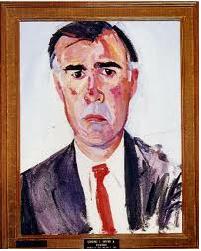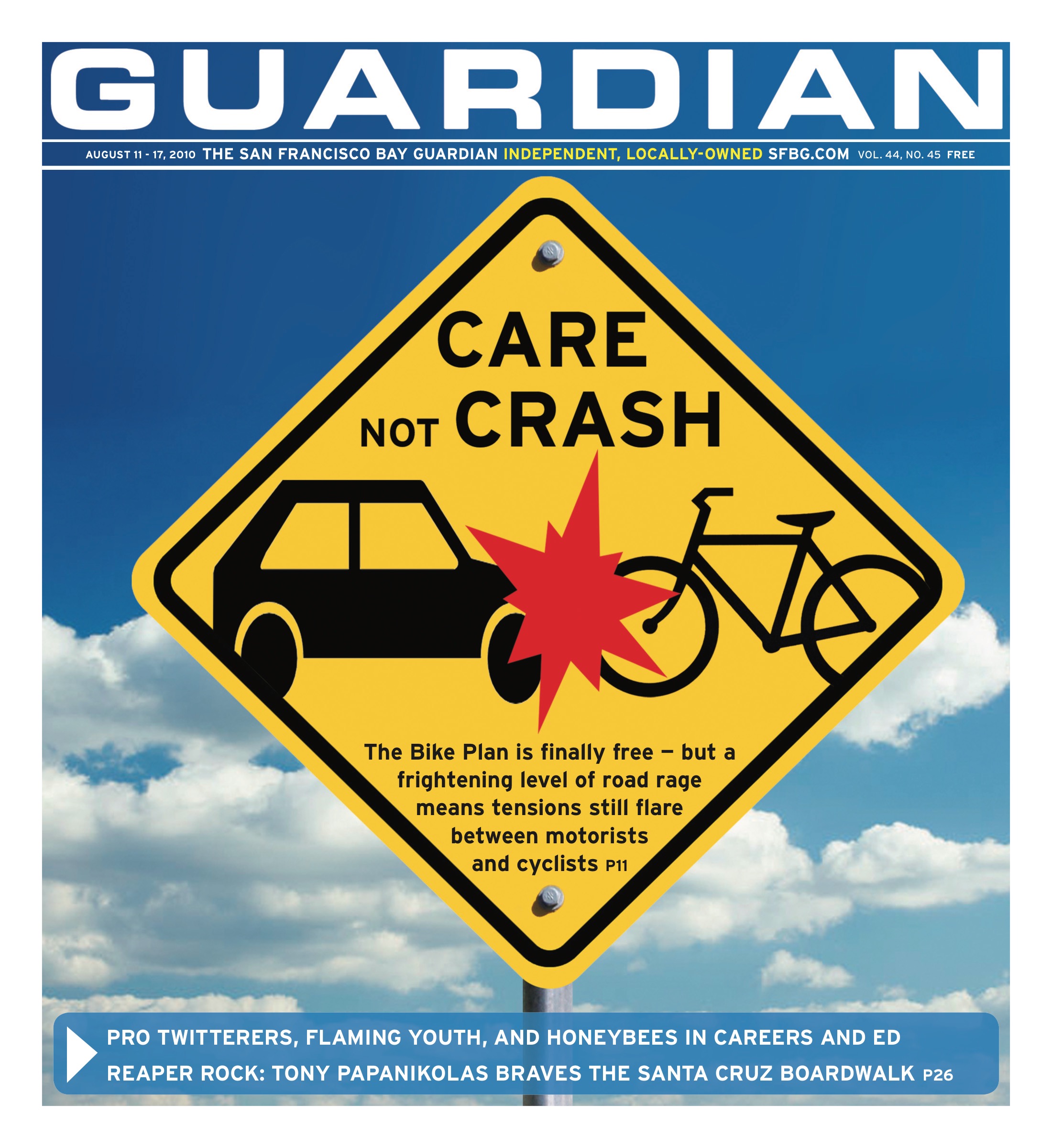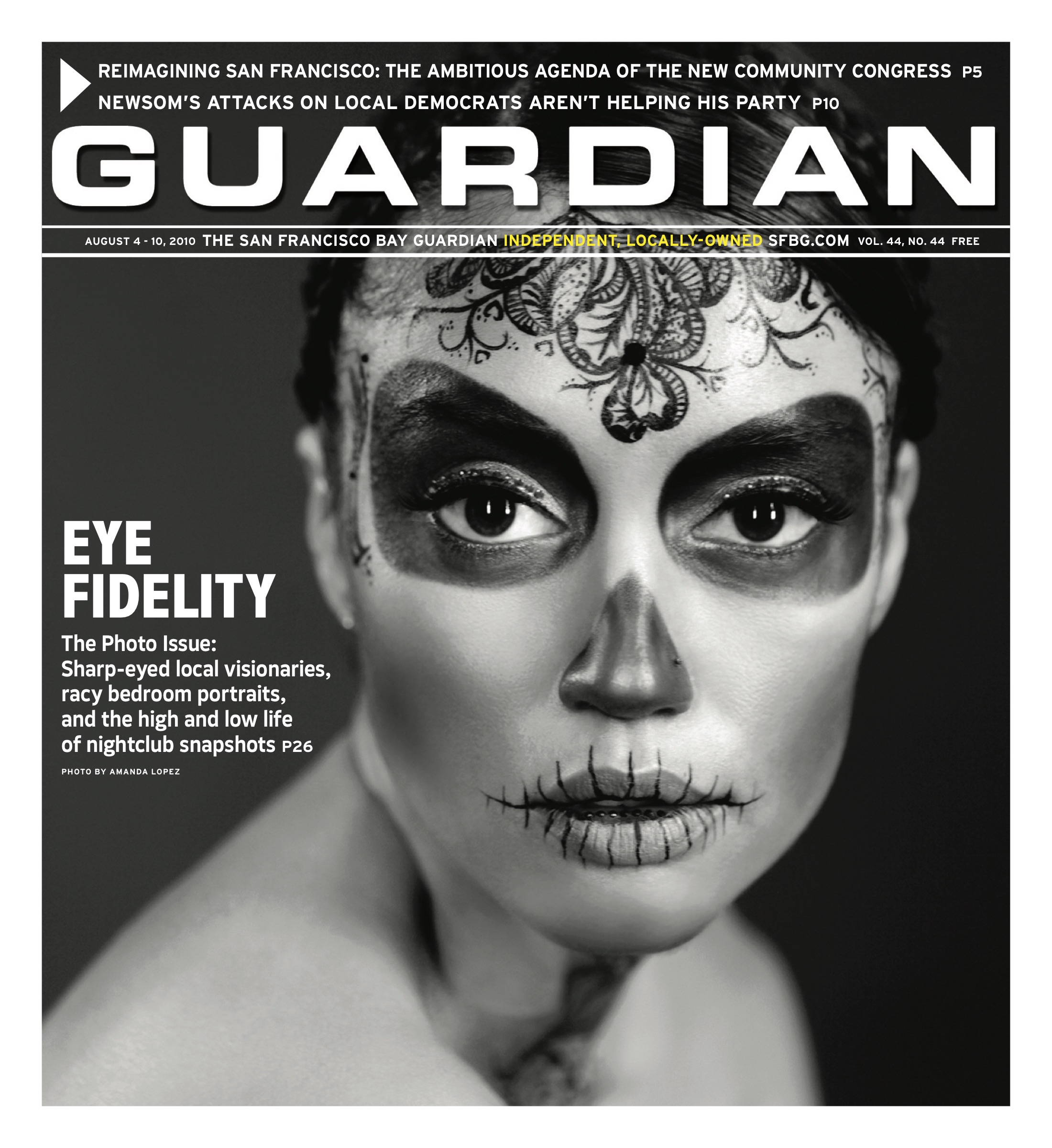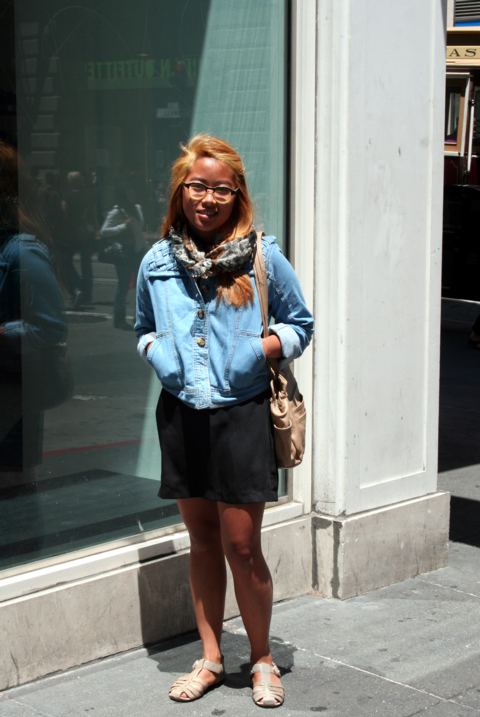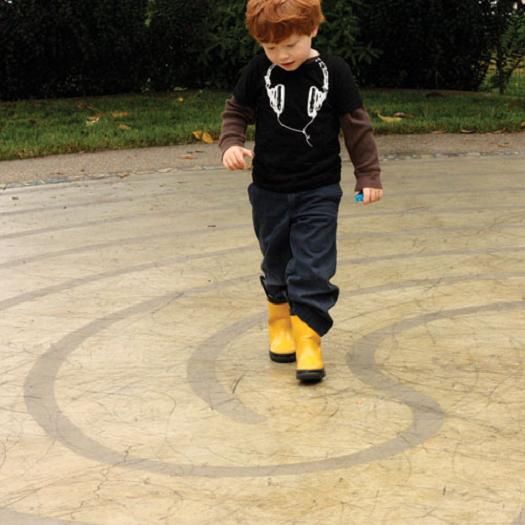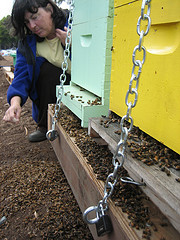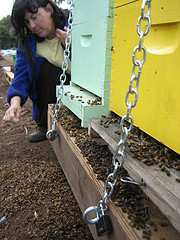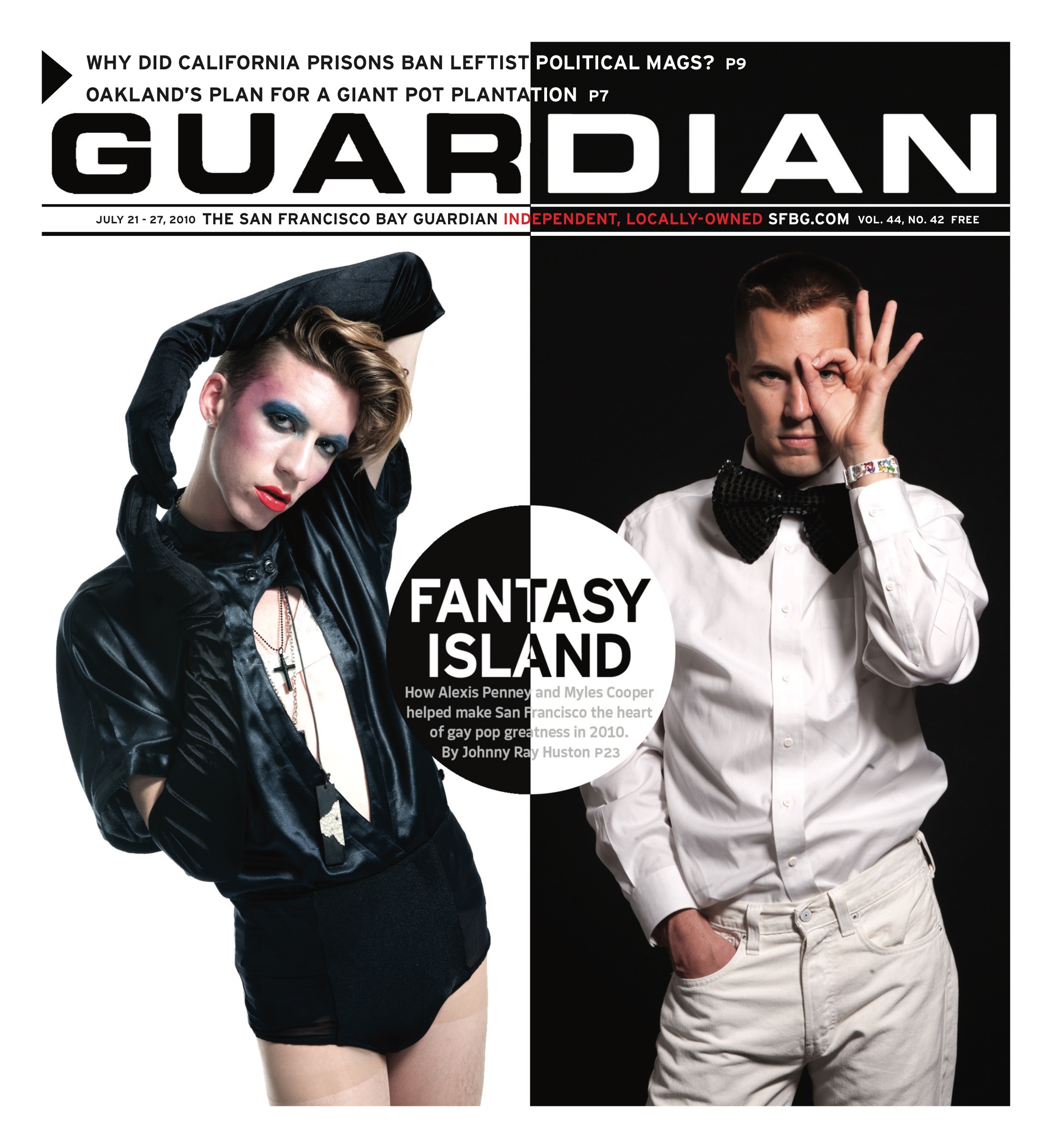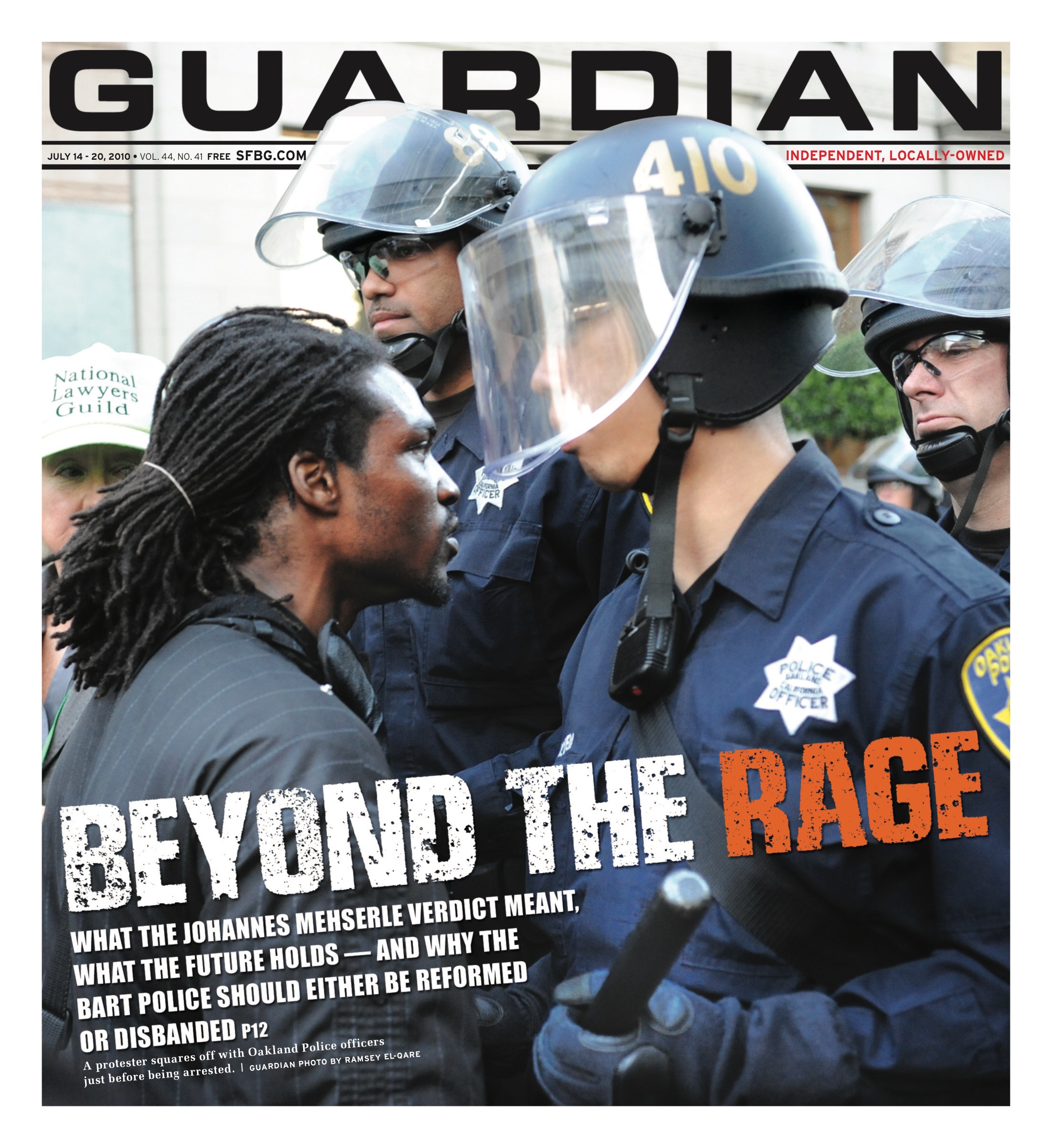Best of the Bay 2010 Editors Picks: Food and Drink
BEST PERKS FOR PROUD PERVERTS
A Web search for every cafe, a cafe for every Web search? All well and good, but what if your search is for the best goldarn double-sided dildo there is — and you’re sick of that uptight suit over there eyeing your Googles? Proudly pervy surf-and-sippers, you officially have a kick-it spot. Kink café and boutique Wicked Grounds not only brews steamy cups of Ritual coffee, but hosts regular meet-and-munches where you can warm up to your next dom, sub, or whatever you’re into these days. The welcoming staff can be easily convinced to serve coffee from a dog bowl for the right slave. (Caution: contents may be hot!) They might also be able to help out with that just-right vibe hunt: shelves by the front counter stock all the finest gear in Super Sexy Toyland.
289 Eighth St., SF. (415) 503-0405, www.wickedgrounds.com
BEST EFA DOSE ON TOAST
When it comes to sardines, you have to think outside the earthquake shelter. On the flavor-ometer, the tinned food of last resort (served on tarps in the shelter with Saltines and stale water) bears no resemblance to its freshly grilled or roasted self. Not only are the little silver herrings tasty, they pack a megadose of essential fatty acids, the stuff nutritionists keep nagging us to eat more of. But no one needs to tell this to the Italian-inspired chefs who created the sardine sandwich at Barbacco Eno Trattoria, the more casual relation of Perbacco in the Financial District. Unlike restaurants that play it safe with sardines by smothering them in mayonnaise and lemon juice, Barbacco tops its sardines with seared calamari. Not most people’s first choice, perhaps, but the two get along swimmingly, especially when served on an Acme torpedo roll and slathered with arugula and “roasted tomatoe condimento.”
220 California, SF. (415) 955-1919, www.barbaccosf.com
BEST HOLE IN ONE
When people start trash-talking donuts, it’s hard not to imagine a life in which the person was weaned on Hostess or Entenmann’s and maybe stepped up to Dunkin’ or Krispy Kreme on special occasions. In other words, we’re talking a lifetime of mass production, where the only donuts these people have encountered spent their nasty, brutish, and short lives being callously blended in giant vats and stuffed into huge ovens, untouched — nay, unkneaded! — by human hands. Not so at Dynamo Donuts & Coffee, the small, open-air stand in the Mission that is diligently working to give donuts a good name. Each day the artisanal bakery makes seven to 10 types of donuts, all by hand. Standouts include the maple-glazed bacon apple, spiced chocolate, and lemon Sichuan filled with lemon curd and Dynamo’s incomparable “dredge.”
2670 24th St., SF. (415) 920-1978, www.dynamodonut.com
BEST FOWL TO TABLE
Which came first: the chickens or the eggs? At Stable Cafe, what probably came first was a commitment to fresh, local, sustainable food, which led to its farm in Santa Rosa, which led to its chickens, which led to its eggs, which led to its egg and cheese breakfast sandwich, which is a savory, molten marvel of scrambled egg and cheddar on thick, toasted Acme bread. But this light, airy Mission District cafe, beautifully renovated by architect Malcolm Davis in one of SF’s original carriage houses, brings that kind of integrity to everything it does. Its credo seems to be, do a small number of things well (know thy chickens; bake thy own muffins) — and adhere it does. And if you want to pay homage to the laying lovelies who created your eggs, Stable has their photos on the wall.
2128 Folsom, SF. (415) 552-1199, www.stablecafe.com
BEST CZECHVARS WITH A TWIST OF BOHEMIA
For a city with such a strong bohemian reputation, San Francisco has surprisingly few spaces that capture some of the flavor of the actual place. Yes, Virginia, there really is a Bohemia — and its capital is Prague. (One prefers the emphatic German spelling: PRAG. No lazy French vowels trailing behind, doing nothing!) And, speaking of nothing, nothing says Prague quite like a mug of the beer known to the Czechs as Budvar but to us, we of the North American market — perhaps because of a potential conflict with Budweiser — as Czechvar. A splendid place to enjoy said beer, whatever its name, is at the aptly named Café Prague. The feel inside is wonderfully Mitteleuropean, while the calorie-rich food emphasizes such basics as starch, meat, and fat. You probably won’t leave hungry, or sober.
2140 Mission, SF. (415) 986-0269
BEST CULINARY MULTIPLE PERSONALITY

Photo by Ben Hopfer
Don’t be deceived; Red Crawfish isn’t some kind of Red Lobster knockoff. The name is (we guess) a sly joke, and the restaurant does offer crawfish. But neither the jokey name nor the serving of crawfish is what makes the restaurant special. No, the reason you’ll remember Red Crawfish is because of its split personality. And although in human beings, split personalities are generally problem personalities, it’s different — and better — with restaurants (in this case, all Jeckyll and no Hyde). By day, Red Crawfish is an ordinary-looking Tenderloin restaurant that lays out an agreeable east Asian menu. But when the sun goes down, the place morphs smoothly into a Cajun spot whose gumbo is superb. Good gumbo doesn’t exactly grow on trees in these parts, so for this dish alone, let us all give thanks to Red Crawfish, whichever one it may be.
611 Larkin, SF. (415) 771-1388
BEST MEXICAN LESSON
If Mexican cooking is underrated in this country, part of the reason must be that we’ve been exposed to fast-food chain tacos and, even in our very own Mission District, overexposed to the burrito — which isn’t even authentically Mexican. God save the burrito anyway; it gives a lot of bang for the buck, and that’s important in these shriveled times for starving students and plenty of others. But there’s a real education to be had as well in the foods of Mexico, and a good place to audit the class is Nopalito, an offshoot of the highly regarded Nopa. The care taken about ingredients matches that of the nearby mothership, and the menu ranges nimbly across regional specialties, many of which are unfamiliar. The carnitas are recognizable, but they are also spectacular. It will be as if you’ve never had them before.
306 Broderick, SF. (415) 437-0303, www.nopalitosf.com
BEST PUPUSAS AND GOOOAAAALLL!!!S
Football and food take on more global connotations at Balompié, and that’s just bueno. The restaurant is well-hung with huge flat-screen televisions showing soccer matches from around the world, and the food is splendidly Salvadorian at a modest cost. This means lots of pupusas and pasteles, along with exotica like pacaya (pickled date palm blossoms), and — to rinse down all this bounty — the Salvadorian beer Regia, which comes in bottles that resemble howitzer munitions. But the best thing about Balompié is that at its heart it’s a sports bar. Men like to watch sports on big TVs while drinking beer, and it doesn’t matter whether they’re speaking Spanish, drinking Regia, or pulling for Costa Rica, pupusas in hand.
3349 18th St. (also at 525 Seventh St. and 3801 Mission), SF. (415) 648-9199 (558-9668, 647-4000)
BEST CREPE ME UP BEFORE YOU GO-GO
What do we miss most about Paris in the spring? The hip-hop boys with their gold chains and exposed biceps, the gamine girls in strappy heels, the constant elusive threat of rain, the crowds at Paris-Plages, laden with beer bottles, acoustic guitars, and joie de vivre. But above all, we can’t help reminiscing about those street crepes, fresh off the griddle, just the ticket for staving off those inopportune late-night hunger pangs, and great for soaking up any excess vin ordinaire in the bargain. Hooray! The 11th Street corridor’s Crepes A Go Go serves up the best street crepes this far side of the Maginot line. Starting at just $2.50, each crepe is made to order, and filled to oozing point with a decidedly Californian array of savory or sweet options. Open until 4 a.m. on weekends, with complimentary French hip-hop and comfy street-side sofa seating in the bargain. Take that, bacon-wrapped hotdog cart.
350 11th St. and other locations, SF. (415) 503-1294
BEST SCONES WITH A SIDE OF ASIMOV
Do you remember when the venerable coffee shop was a place people gathered to hang out instead of network? Where gamers would shuffle their Magic decks, writers would swap paragraphs, readers would sit quietly for hours with a good book and a pot of tea, and caffeine-fueled college kids would cram like the dickens? Welcome to Borderlands Café, the newest darling of the Valencia Street corridor. An offshoot of the classic Borderlands Books sci-fi bookstore, it’s already attracted quite a cross-section of trend-spotting caffiends and café nostalgists who just want to converse without being shushed by perfectly-coiffed app-oholics. And with a huge selection of magazines, comfy chairs, and scrumptious cheddar cheese and onion scones, Borderlands has a lot to offer even the solo café dweller. Except for Wi-Fi, which is actually our favorite perk of the place.
Borderlands Café, 870 Valencia, SF. (415) 970-6998, www.borderlands-cafe.com
BEST MOUTHWATERING MAYAN
It’s not situated in a chic location, unless you’re looking for snazzy new rims or a car wash. But Poc Chuc is well worth a trip down a less-bustling stretch of 16th Street for its unique Spanish-Mayan fusion cuisine. Open for lunch and dinner five days a week, the small, unadorned restaurant offers an array of dishes that inject an ancient, mouthwatering twist into standard Latin American fare. (Think plenty of smoked turkey, grilled tomatoes, pickled onions, and, of course, maize in several iterations.) A platillo Maya appetizer platter combines some of its tastiest, bite-sized creations, with plenty to share among a group — but no fighting over the pork empanadas or turkey salbutes! Main dishes include the signature Poc Chuc — grilled citrus-marinated pork topped with grilled tomatoes — and a reliable daily specials menu. Go for the mole!
2886 16th St, SF. (415) 558-1853, www.pocchuc.com
BEST GOOEY MAGIC (NO ELVES REQUIRED)
If you don’t like cookies, feel free to skip ahead. But if you were born with taste buds and an appreciation for delicious gooeyness, you’d do well to hit up Anthony’s Cookies. There is indeed an Anthony — likely you’ll see the man himself when you stumble into his Valencia Street shop, lured by the prospect of fresh, hot, calories-be-damned treats. And if Anthony looks like the happiest guy on planet Earth, he probably is — he bakes cookies for a living, after all — using only natural ingredients. Who’s magical now, Keebler Elves? Flavors include the usual suspects, plus variations on chocolate chip (semisweet, with walnut, using white chocolate … ) done to soft-meets-crisp perfection, plus inspired creations like cookies and cream and whole wheat oatmeal.
1417 Valencia, SF. (415) 655-9834, www.anthonyscookies.com
BEST XXX
Sink happily into the dark brown booths at Baker and Banker for a memorable Cal cuisine dinner — sweet corn bisque with a plump lobster hush puppy, maybe, or sausage-stuffed quail in a coffee-molasses glaze. Husband and wife chef duo Jeff Banker and Lori Baker get it right with each dish. But you could visit for dessert alone with Lori’s ever-changing wonderland of a dessert menu. In fall, dessert might be pumpkin cobbler, steaming hot with a crunchy top and cooled with candied pumpkin seed ice cream. In summer, a cherry tarte tatin accented by salted caramel and amaretti rules. Awesomely, the Baker and Banker’s XXX triple-dark chocolate layer cake is a constant. This orgiastic slice stands tall with a bottom layer of dark, dense flourless chocolate. Not to be outdone, the middle is a tangy chocolate cheesecake, while the top finally gives you a density break with traditional chocolate cake. One of the more satisfying threesomes in town.
1701 Octavia, SF. (415) 351-2500, www.bakerandbanker.com
BEST FRESH KASHI PAN
Sandbox Bakery is a pocket-sized cafe in Bernal Heights serving Ritual Roasters and De La Paz coffee with classic pastries like Valhrona chocolate croissants or orange currant scones. But it doesn’t end there. Owner and pastry chef Mutsumi Takehara’s background ranges from Slanted Door to La Farine, and her creations span a world of taste. Sandbox’s Japanese sweet bread, or kashi pan, is a lightly sweet brioche filled with the likes of melon or yuzu marmalade with sage. Or, in its savory form, it comes challah-like with negi-miso, curry or red bean paste filling. Daily special sandwiches often express a fusion of cuisines: Thai chicken croque-monsieur; an apple, smoked gouda, and rosemary spread over fresh baguette, or a teriyaki chicken rice burger with sticky rice as bun. A Zen-like experience with Parisian spirit.
833 Cortland, SF. (415) 642-8580 , www.sandboxbakerysf.com
BEST HOT HAKKA
Not familiar with Hakka cuisine, the regional cooking style of Southeast China that’s got food bloggers in a hot lather? It’s time you became acquainted. Head to the Outer Richmond and get schooled at Hakka Restaurant. Hakka looks like any other nearby Chinese joint, but there’s a legitimate pride in the service and an uncommon freshness to the food. Dishes include salt-baked chicken, fried strips of pumpkin coated in salted egg, crisp Chinese broccoli sautéed in rice wine, and ngiong tew foo, or stuffed tofu cubes. Kiu nyuk, a beloved Hakka dish, has two known versions, the more common served here: fatty pork belly layered over preserved mustard greens and mushrooms in a dark and complexly herbal sugar-soy sauce. Slice through layers of skin and fat to the tender anise-scented meat and you’ll be hooked on Hakka.
4401-A Cabrillo, SF. (415) 876-6898 BEST FRIENDLY YEMENI
This spring, on the western edge of the Tenderloin, a humble little restaurant opened quietly: Yemeni’s. Owner Ali Abu Baker and his staff convey a warmth almost equal to that of the piping Yemeni bread coming from the oven (useful for sopping up hummus with strip steak). Shawerma, baba ganoush, tabbouleh, and other Middle Eastern favorites are available. But the real draws are traditional Yemeni dishes like salteh, the country’s national dish: a meat stew topped with hilbeh — a tomato-based, chutney-like dip spiced with fenugreek, garlic, and cardamom — and zhug/sahaweq, a hot pepper sauce. Sip Yemeni coffee accented with a spice mix called hawayij. Baker shares his passion for his native country’s food at prices that encourage feasting for mere dollars. Stop into neighboring Queen of Sheba market for Middle Eastern groceries to complete your culinary journey.
1098 Sutter, SF. (415) 441-8832, www.yemenirestaurant.com
BEST SLAMMIN’ KOREAN STEAK SANDWICH
Rhea’s Deli is an unassuming, even demure, counter hidden inside a Mission District convenience store. But then the bad-ass $8 Korean steak sandwiches come out and the gloves come off. You’ll be fighting for — or at least gladly waiting up to 30 minutes in line for — a chance to sink your teeth into one of these babies. (Smart steakers call ahead and preorder). Once you’ve scored, it’s tempting to wolf down this mountain of tender, spicy Korean beef, shredded cabbage, red onions, and cheddar cheese on a crunchy baguette. Avoid this animal urge and take it slow, allowing the pleasure to last. Rhea’s offers an array of other savory lunchables as well, from a katsu sandwich with pork loin fried in Japanese breadcrumbs to a 19 Street sandwich with roast beef, Vermont cheddar, pepper jack, avocado, and pickled jalapenos. But, you know, steak.
800 Valencia, SF. (415) 282-5255
BEST BEELZEBUB BREW
The appropriately named Coffee Bar offers a double whammy of appeal: it occupies an impeccably cool industrial-looking space for laptop workaholics and serves some truly eye-opening coffee. Mr. Espresso coffee beans provide the kick in bracing espressos and cappuccinos; an ultra-expensive, ultra-shiny Clover machine dispenses perfect single cups. Unlike chain-like offerings of watered-down, cloyingly sweet mochas and “specialty” coffees, the additional drink menu items here are crafted with punch. Vietnamese or Havana coffees (conveniently hot or iced for those variable summer days) are sure things. But our taste buds go up in flames for Coffee Bar’s El Diablo. A devilishly smooth mix of espresso, chipotle-infused milk, and Guittard chocolate, the robust brew marries a hint of cocoa sweetness to subtle heat. Yes, we’re probably going to hell for worshipping El Diablo. But at least we’ll be awake for it.
1890 Bryant, SF. (415) 551-8100, www.coffeebar-usa.com
BEST OCCASIONAL KANGABURGER
Trek to a mellow stretch of Clement Street and enter the “five-star dive” environs of Tee Off Bar & Grill. You might assume it’s all right for a beer and little else — but you’d be wrong. The place is comfortably worn, sure. But regulars and staff soon feel like old friends, often sharing one of their spare Bronx Bombers (fiery BBQ chicken wings) or beer-battered mushrooms. The next surprise comes when you exit the dim interior to a sunny back patio with picnic tables and random paraphernalia from popular pirate parties (ask your bartender). A chalkboard reveals weekend specials. Wait! Is that a $20 kangaroo burger? After you’ve balked at the price, you can’t pass up this adventurous challenge, especially when the burger is plumped up with fried onions and kiwi relish. Make sure you call ahead, since Tee Off only serves it on occasional weekends and until supplies run out. If the roo’s already hopped, other worthy eats like ostrich burgers or Paul’s Crafty mac ‘n’ cheese, a four-cheese blend with pancetta blessed by Guy Fieri himself, will satisfy.
3129 Clement, SF. (415) 752-5439, www.teeoffbarandgrill.com
BEST DEVILED DELIGHT
When the rustic-chic Marlowe first opened, it offered a seemingly straightforward menu of bistro staples like steak frites and cheesy cauliflower gratin that seemed anticlimactic. But chef Jennifer Puccio’s faith in the classics and elegant marshaling of simple ingredients soon paid off: raves began to roll in — especially for the jaw-widening burger loaded with caramelized onions, horseradish aioli, and bacon. But the burger isn’t the only star on the lunch menu. Diving into Marlowe’s deviled egg sandwich is not settling for second best. Simple in presentation, it’s one of the finest egg sandwiches out there, an open-faced beauty with a layer of crisp, meaty bacon, aged provolone, pickled chilis, and horseradish aioli on the side (perfect for accompanying fries). Order addictive brussels sprout chips and let the office know you won’t be back for a while. The only proper way to wrap up such a heartwarming lunch is to take a nap.
330 Townsend, SF. (415) 974-5599, www.marlowesf.com
BEST SOUS-VIDE SOUS-BUDGET
One expects to shell out a pretty penny to partake of gourmet cooking techniques like sous-vide, or vacuum-packed slow cooking. But Berkeley’s eVe defies such expectations with a palate-tickling, surprisingly filling two-course prix fixe menu for $25 that includes several sous-vide items. The set menu offerings change often (additional items are steadfastly priced at $11 each), but husband-and-wife chef team Christopher and Veronica Laramie always keep it lively, highlighting the tastes of Veronica’s native Peru. Grilled squid ink risotto gets a tart kick from candied kumquats and yuzu. Diver scallops are brightened by lime leaf, edamame, mint, and delicate salmon roe. A sizable piece of fatty-licious pork belly pairs with a warm watermelon radish, chive flower, and a paper-thin slice of candied Buddha’s hand. Dessert might be goat brie sweetened with apricot, red wine, and a welcome contrast of shallots and flax seeds. In other words, world-class gastronomie d’avant-garde priced to appeal to ramen-weary students.
1960 University, Berk. (510) 868-0735, www.eve-berkeley.com
BEST BAR BRUNCH WITH BUNNY CHAO
It is with humor and reverence that one dines at Three Papayas, a pop-up Sunday brunch from 12 p.m.-4 p.m. at Doc’s Clock bar. Mismatched Michael Jackson placemats abound, and Bibles and porn-laced comic books act as menu-holders. Creative chef Ta-Wei Lin emphasizes fresh and funky Vietnamese and Thai flavors. His menu of four or five changing items per week (everything is $8) might include pan-fried rabbit, Filipino sisig, chicken or vegan Vietnamese crepes, or viet banh canh with clams and coconut sauce. If it’s available, hop on the unusual Bunny Chao, a hollowed-out loaf of bread — filling piled neatly on the side — overflowing with green lentils, veggies, and cardamom pods. Chef Lin garnishes with seasonal fruits like figs, passion fruit, and, of course, papayas, making his plates fun to behold, but even better to eat. In the lovably grungy Doc’s setting, pair your food with a peppery bloody mary, and join your fellow dive-tastic brunchers in a round of hallelujahs.
2575 Mission, SF. (415) 824-3627, www.docsclock.com
BEST BIG EASY OVER EASY
Morning at Brenda’s French Soul Food: where to start? Grillades and grits or crawfish beignets? Fried shrimp po’boy or sloppy Josephine? Eggs and andouille? Oui, Oui! This wee spot on Polk Street — open for breakfast, brunch, and lunch — is a showcase of the strikingly huge flavors of New Orleans-style French and Creole cuisines. The portions are big, the atmosphere strikes a note between quaint and cosmopolitan, and wonderfully named Filipino-Creole chef (and New Orleans native) Brenda Buenviaje keeps the flavor flowing. The only drawback, besides having to brave the tiny curbside riots to get in, is having to choose among the many dreamy menu items on offer. Make sure, however, to wash down Brenda’s must-try gumbo with a glass of sweet watermelon iced tea before proceeding to the next steaming dish.
652 Polk, SF. (415) 345-8100, www.frenchsoulfood.com
BEST SLICE OF SPICE
From slammin’ New Mexican resto Green Chile Kitchen comes Chile Pies, a low-key dessert café offering a spicy paradise of crave-inducing organic sweets. Seriously, if you thought Southwestern desserts were frozen in a sticky Bimbo-landia of saturated fats, this joint will blow your buds. Blue corn waffle cones, Straus Family soft-serve, Café Gratitude raw vegan ice cream, and fantastic floats (ginger ale with cardamom ice cream, anyone?) are just a few of the tasty treats at the Panhandle hot spot. The main draw is the rotating cast of daily pie specials, from the simple, like banana cream, to the sophisticated, like a tangy green chile apple with walnuts and red chile honey drizzle. Can’t decide between a scoop of Three Twins Ice Cream or a slice of chocolate peanut butter pie? No problem, have both in the form of a frosty pie shake. And then there’s Chile’s piece de resistance: a classic Frito Pie, with organic Niman Ranch beef and Mexican red chile. You can have pie for dinner and dessert.
601 Baker, SF. (415) 614-9411, www.greenchilekitchen.com/chilepies
BEST GIANT FEAST FOR GIANTS FANS
Do thoughts of those wallet-demolishing $9 beers at AT&T Park leave you with a sinking feeling in your stomach? There’s no need to get shut out of lunch or dinner plans around game time — hightail it to nearby Hard Knox Café for a true meal steal. Heaping soul food plates of smothered pork chops, Cajun meatloaf, barbecued spare ribs, and chicken and waffles, available at super-affordable prices, will last you all 54 outs and then some. Hard Knox’s no-nonsense shrimp po’boys and hot link sandwiches to go will keep you doing the wave through extra innings at a fraction of ballpark prices. Better yet, order a perfectly battered pile of fried chicken, settle into one of the comfy booths, and watch the entire game on the flat screen. You can order round after round from Hard Knox’s stellar selection of microbrews without missing a minute of the action.
2526 Third St., SF. (415) 648-3770, www.hardknoxcafe.com
BEST VIRGIN KICK
Don’t know about you, but we periodically have these Jack Nicholson Five Easy Pieces chicken salad sandwich moments at oyster bars, where we want to say, “We’ll have an order of oysters with lemon, cocktail sauce, and horseradish. Now hold the oysters — and bring me the lemon, cocktail sauce, and horseradish.” That’s why whenever we order a virgin Mary at Rose Pistola in North Beach, we get the spooky feeling that the bartenders have read our mind. The secret of their piquant housemade mix is, according to several staff members, secret (although one staffer did divulge that the bartenders add horseradish to the traditional tomato juice-Tabasco-Worcestershire combo). On top of this, Rose Pistola adds a green olive, pickled onion, and slice of lemon. You won’t even miss the vodka — or the oysters.
532 Columbus, SF. (415) 399-0499, www.rosepistolasf.com
BEST MIX MASTER, WITH MARMALADE

Photo by Ben Hopfer
A tucked away, speakeasy-like space on the second floor of the Crescent Hotel, minus the masses and snobbery: that’s where you’ll find the Burritt Room and its founder, master mixologist Kevin Diedrich. In the brick-walled space accented with sparkly chandeliers, black and red couches, and white piano, Diedrich shakes and stirs from a reasonably-sized menu of 18 rotating cocktails. He doesn’t just craft the classics, though there are plenty of those. Diedrich also creates inventive new drinks — often featuring marmalade — like the sparkling Hitachino Sour with bourbon, orange marmalade, lemon, sugar, and orange bitters, topped with Hitachino White beer. His experience lies in some of the country’s greatest bars from East to West. Diedrich sets a welcoming, unpretentious tone, has assembled a tight team of bartenders, and will take you on tasteful journeys nostalgic and new.
417 Stockton, SF. (415) 400-0500, www.crescentsf.com
BEST VEGAN CHARCUTERIE
Oh, if all our utopias were this dreamily delish. Ideally situated on green perch of reclaimed woodland on the edge of the UC Berkeley campus, halcyon eatery Gather offers seasonally minded, meticulously sourced food (complete with a sizable, possibly TMI volume, available to diners, detailing all providers and particulars). Vegetarians and vegans will be pleased to know that former Millennium sous chef Sean Baker has given much thought to its selections: the menu is 50 percent vegetarian, the star of which is undoubtedly the artisanal vegan “charcuterie” platter, which might include the most delicate tofu-skin tower or an Tuscan Rose eggplant with cashew “ricotta” and fennel-top pesto. Expect biodynamic and organic California wines, as well as piquant cocktails like the Secret Breakfast, composed of smoked peach scotch, bacon cello, spicy honey, and egg whites.
2200 Oxford, Berk. (510) 809-0400, www.gatherrestaurant.com
BEST BOW TO THE ANCIENT BACON GODS OF CATALUNYA
With or without you, we’re set to indulge our love of refined yet pleasure-minded Catalan cooking — and the pitch-perfect Contigo, which translates as “with you,” has us murmuring “Bon profit!” like a native of the land of Gaudi and Dali. The crowds have made this industrial-moderne Noe Valley restaurant the most popular spot in the hood for its wonderfully authentic Catalan tapas, artisanal Spanish and stateside hams, and fresh Catalan flatbreads — studded with wild nettles and porcinis (add a farm egg, anchovies, or Fatted Calf bacon). Aficionados of whole-critter eating won’t shy away from the tripe and chorizo and chickpeas or the oxtail-stuffed piquillo peppers, all sourced from local organic providers. And everyone, including the finicky ankle-biters, will want the albondigas, or pork and ham meatballs. For here the pig reigns supreme, even on the cookie plate, which includes a piglet-shaped peanut butter and bacon number.
1320 Castro, SF. (415) 285-0250, www.contigosf.com
BEST ITTY BITTY TREATS FOR TWI-HARDS
Moist and addictive, this blood-red baby is so tiny it’s totally OK to sink your fangs into a foursome and not break the Eternal Oath of Your Diet. Sure, his type wasn’t born yesterday, but damn, the way he stares at you, his skinny jeans, that whipped topping that glistens in the sun … the Rich Red Velvet cupcake at Cups and Cakes Bakery, named for its deep, vampire-luring color and smooth, timeless flavor is enough to blow our Team Edward minds. (Jacobites can tear into other flavors on offer, like Pretty Pretty Princess and Rainbow Bright. Just sayin’.) Did we mention the rich swirl of cream cheese and the crimson sprinkles? Que bella! Step into Jennifer Emerson’s beckoning SoMa bakery and drool over the perfectly constructed cuppies therein. And don’t worry, these beauties won’t make you wait three sequels for your first bite.
451 Ninth St., SF. (415) 437-2877, www.cupsandcakesbakery.com
BEST AL FRESCO FEEL-GOOD
Nestled amid boxy-lofty tech startups and the frenetic energy of AT&T Park lies the small green courtyard wonderland of Crossroads Cafe. The sprightly enterprise is a component of the Delancey Street Foundation, one of the country’s most innovative self-help organizations for the homeless, which has filled up this quiet little SoMa block with 370,000 square feet of housing, vocational schools, and the well-regarded Delancey Street Restaurant. But at Crossroads, all that is readily apparent of this commendable social enterprise is the distinct impression that the staff — composed mostly of Delancey residents learning workforce skills — wants to create the best darn cafe ever. Proceeds from the large menu go toward resident education and support. Pass through the small bookstore and grab Michael Chabon’s new bestseller, order a housemade waffle or scoop of coconut ice cream, and settle into a seat on the garden patio for a little soul sunshine.
699 Delancey, SF. (415) 512-5111, www.delanceystreetfoundation.org
BEST MICROBREW MUTINEERS
You’re always down for a 40 on the corner, a Bud on the stoop, or a PBR from your purse on Corona Heights. But sometimes you want an actual beer. You know, the kind that doesn’t taste like you wrung out a hipster’s legwarmers in your mouth. You’ve considered venturing into the labyrinth of microbrews, but microbrew culture turns you off — kind of snobby, kind of midlife-crisis-y, definitely confusing. Relax and revolt: Beer Revolution, downtown Oakland’s new grade-A beer store, will guide you into superlative suds with deep knowledge and just the right amount of edge. Staff connoisseurs offer tastes of recommended nectars, and a generous deck studded with picnic tables encourages kicking up your Doc Martens and glugging with abandon. Besides bottled bounty, there’s a spirited band of ever-rotating, ever-satisfying selections on tap, like Meantime Scotch Ale, Caracole Nostradamus, and Alagash Black. Slip on a balaclava and pop a few caps at bland brewskis.
464 3rd St., Oakl. (510) 452-2337, www.beer-revolution.com
BEST SWEET BEWILDERMENT
You know those foodies (maybe you’re one) — so up on the blogs and culinary porn rags they think they’ve tasted everything under the sun. Well, unless these epicurean explorers have logged some serious hours at 100% Sweet Dessert Café in the Outer Richmond, they’ve surely left some sugary stones unturned. You simply will not find a menu that covers more enticing and bewildering acreage — at least 10 massive pages illustrated with a complex grid system that showcases a dazzling plethora of Asian desserts. Two you might want to sample: crystal rolls (clear rice paper sachets of sweet sugary goo and fresh mangos and strawberries) or a selection from the extensive jelly drink section of the menu. Sure, the many of the sample photos look like fairy tale versions of your saltwater aquarium’s decorative fauna, but your fish seem to lead delicious lives, right?
2512 Clement, SF. (415) 221-1628
BEST TOTALLY WORTH-IT TOOTHACHE

Photo by Ben Hopfer
When Jamie Kasselman hands you a box on your birthday, you better be stoked. Presentation is key. Before opening her candy store in the Marina, she was famous for her impeccable flair for arranging sweets on designer dishes — a clear inspiration for the achingly sweet décor at Sweetdish. Kasselman has it well stocked with classic candies, designer chocolates hailing from mouth-wateringly diverse locales ranging from Colombia to Ghana, and even some treats made closer to home. (Kasselman makes her own line of fantastic homemade flavored marshmallows. Want-want-want!) It can be difficult to decide between all the fanciful bulk candy options — we’re naturally drawn to all the strawberry and lemon goodies — but the pretty salesgirls will feed you samples of from bags of irregulars behind the counter if you ask … sweetly.
2144 Chestnut, SF. (415) 563-2144, www.thesweetdish.com
BEST VIRTUAL VEGGIE GURU
Vegetarian goddess Heidi Swanson started her essential 101 Cookbooks blog way back in the ancient year of 2003. It was a way to start putting her massive cookbook collection to use, combining her love of cooking with her interest in photography. The result is a comprehensive vegetarian go-to guide for making simple, delicious recipes infused with her own San Francisco flair. Swanson focuses on natural, whole foods and ingredients, frequenting SF’s many farmers markets and organic foods stores. Then she tells readers how to whip up gems like chile blackberry syrup, Tuscan ribollita, and Rajasthani buttermilk curry. Each post walks you through her experiences with colorful photos and descriptions, substitution suggestions, and cooking tips. She’s since published two meat-free meatspace cookbooks of her own — mere amuses bouches to her blog, which contains reams of virtual veggie lore. If you ever wondered what the name of that funny squash is or what to do with halloumi cheese, give her a click.
www.101cookbooks.com
BEST PICKLED PLEASURE REVIVAL
Oh, pickled egg! Like your glass-jarred, vinegar-soaked, bar-top cousins the pig’s foot and the giant gherkin, you have for years endured the tipsy sneers and simulated gagging of drinkers who never gave you a chance. Once the prince of any bar worth its salt, an easy snack for barflies and hofbrauistas alike, you slipped into ovoid obscurity. Now one bar has resurrected your sweet purple form by giving it a gourmet spin. Who’d pass up a go at pickled quail eggs at the Alembic in this age of adventurous eating? It just goes to show that if you repackage something, provide the proper ambience, and price something at $2, you can get someone to eat just about anything. Perfect with Alembic’s saucy cocktails, you’re a hit with highbrow tipplers. Now please put in a good word for your forgotten cousins.
1725 Haight, SF. (415) 666-0822, www.alembicbar.com
BEST CUTE CUBANO
Any eatery can slap some pulled pork and pickles on a panini and call it a Cuban sandwich. But true Cuban food connoisseurs venture to Market Street’s upper climes to dig in at the tiny Chan Chan Café Cubano, a cute café by day that at night becomes a paradise of traditional dishes prepared with a gourmet touch. Entrees like ropa vieja and pollo en hoya are spectacular, but you may just pack them up to go after feasting your way through the well-priced tapas menu, which includes scrumptious croquetas, hongos, and camarones criollos. Plus, hello, a couple pitchers of sangria. With true Cuban flair — when the electricity goes out, as it sometimes does, a rewarding fever of culinary improvisation descends — and a laidback, handsome staff (yes, you may have to wait a bit for your order to come out of the one-stove kitchen, but you’ll have plenty to look at), Chan Chan is indeed one of those “hidden gems.”
4690 18th St., SF. (415) 864-4199
BEST DAMN CIOPPINO

Photo by Ben Hopfer
Best cioppino? Them’s fightin’ words in San Francisco, where the thick, rich seafood stew originated. But we’re serious. As certified fish freaks always eager for a fix of this blues-obliviating local delicacy, we’ve tried our fair share. And we can safely say that the home-style cioppino at Sotto Mare is the best. The key — besides the incredible tang of the smoky tomato broth and flawlessly fresh crab and fish chunks, scallops, mussels, and shrimp loaded within — is the atmosphere. Run by beloved, no-nonsense North Beach legend Gigi Fiorucci (don’t squeeze that lemon wedge over your superbly grilled sand dabs or he’ll reprimand you), Sotto Mare has a true family feel, a bustling business of diverse diners, and a haphazard décor that recalls San Francisco’s ramshackle maritime past. When that steaming cioppino tureen, more than enough for two, is placed on the table by the gregarious waitstaff, you feel a delicious connection to SF history.
552 Green, SF. (415) 398-3181, www.sottomaresf.com
BEST WIENERAMA
Never mind the ubiquitous fancy food carts or “third wave” coffee shops springing up in back alley garages — wieners were everywhere this past year. The explosion of gourmet and not-so-gourmet hot dog stands, joints, and full-on restaurants worked to balance all the epicurean exotica with some down-home comfort for those who were raised in a broke-down Chevy on televised baseball and McDonald’s apple pies. All were worthy, but one in particular consistently heated our buns: Showdogs. This “emporium of sausages” keeps it classy with a spotless, tin-tiled interior and organic ingredients like wild boar and merguez, while still appealing to the everyday eater with a sporty sense of humor — we’re suckers for the 49er, an all-beef Schwartz dog with housemade mustard, arugula, and, gasp, real sauerkraut. Add some barbecue fries and a Trumer Pils, and this hearty barker wins best in show.
1020 Market, SF. (415) 558-9560, www.showdogssf.com
BEST PLACE TO HORK DOWN HALF A BIRD
“I just ate half a chicken.” That declaration is written on a Post-it stuck to a cubicle at the Guardian offices. The sticky piece of pastel paper has since been signed by other people besides the original chicken lover. What can you say? Unless you’re the staunchest vegetarian, sometimes you just get the urge to eat half a chicken. Thai BarBQ in Potrero Hill was ideal for such moments, but it’s flown the coop. Luckily, Baby Blues BBQ is here to satisfy those extra-intense and voracious aviary cravings. The restaurant’s Marion County slow-smoked yard bird is served with a tangy barbeque sauce, but be sure to ask for the special Sassy Molassy molasses sauce. Add in corn bread and a choice of two fixins (sautéed okra, mac ‘n’ cheese and corn on the cob are some of the best options) and at a grand total of $15, you’ve got a deal only a fool would cluck-cluck at.
3149 Mission, SF. (415) 896-4250, www.babybluessf.com
BEST RAMEN PHENOMENON
We all know about chicken soup for the soul, how about delicious soup for the skin? Because its pork bone broth contains collagen and calcium, tonkotsu ramen has a rep as the genuinely edible version of a spa facial. There are some delicious tonkotsu ramens in Vancouver and San Francisco, but they’re all matched and even superceded by the subtle one at Asuka Ramen, which manages to be rich and light within a single spoon-size sip. Ramen establishments have popped up all over the city in the last year or two, but Asuka steers clear of trendy trappings and delivers the low-priced goods. Tantanmen is Asuka’s go-to dish, but if you don’t confuse greasy strong flavor with deliciousness, its pork-and-egg laden tonkotsu is the type for you.
883 Bush, SF. (415) 567-3153
BEST BEEF LULU
If life was little more than vodka and pastries (with no hangovers), we’d be in heaven, and the best place to shop would be Royal Market & Bakery. Even here on this mortal playground, Royal Market and Bakery is in the running for greatest shop. Why? Tasty marinated quail, excellent caviar, homemade hummus, fresh fruit, savory eggplant rolls with cheese, dark Russian chocolates, Turkish coffee, a tremendous selection of chilled vodkas and other liquor, an overflowing nook of flaky pastries, and last but not least, Beef Lulu. A special seasoned dish of ground meat, Beef Lulu is as enjoyable as its name is funny. At a time when the city is being overrun by generic chain supermarkets, Royal makes the case for individuality devoted to regional cuisine. And the prices are better, too.
5335 Geary, SF. (415) 221-5550
BEST BASKET OF UBE
On a busy street south of San Francisco lies a little land of leavened love where all your Filipino baked goods needs are met with a sweet smile and an even sweeter pandecoco. We won’t require 20 questions to tell you where: the place is Bread Basket, a starkly outfitted bakery famed for its thrillas from Manila. The neighborhood favorite is BB’s pandesal, swiped fresh out of the ovens while the packs of the bun-like lovelies are still aromatically steamy. Need to bring home a little something for dessert? The joint has cornered the market on delights made from the meat of the ube, or purple yam, which Bread Basket magically transforms into the bun fillings and feathery, marzipan-like candies that sit alongside its more familiar cookies and breads.
7099 Mission, Daly City. (650) 994-7741, www.breadbasketca.com
BEST QUE SYRAH, HURRAH
Tucked in a sliver of a space in the West Portal commercial strip is the tantalizing Que Syrah wine bar, founded and presided over with skill and affection by the team of Stephanie and Keith McCardell. Que Syrah is the perfect place to savor a glass of wine in a friendly neighborhood setting: quiet, unpretentious, and specializing in unusual wines from small production wineries from all over the world. Stephanie and Keith serve by the glass or in intriguing flights and provide expert notes about the wine, the winemakers, and the regions involved. Every Thursday night, an array of delectable tapas enliven the tastings — chef Val Desuyo takes inspiration from his regular trips to the restaurants of Barcelona. Plus: quarterly paella parties! Seafood paella and a glass from Penedès? Sì, sì!
230 West Portal Ave., SF. (415) 731-7000, www.quesyrahsf.com
BEST LOBSTER ROLLIN’
Whatever queasy misgivings you may harbor about the phrase “mobile seafood shack” will instantly be dispelled once you’ve palmed (or tried to palm) a hefty Maine lobster roll from Sam’s Chowdermobile. We were turned on to this tender, brimming-over prize when one of our East Coast-native amigos texted “lobster roll = real deal” from Golden Gate Park, where you can find the edible aquarium on wheels most weekends. So we tried one for ourselves, and yep. Great lobster rolls at a reasonable price are surprisingly hard to come by ’round these Left Coast parts — we’re crabby that way. Luckily Sam’s, the mobile unit of Half Moon Bay resto Sam’s Chowder House delivers the goods. (The roll proper is enough to feed two — order a single-serving “shortie” if you want one all to yourself.) Prep yourself for crustacean heaven with a bowl of Sam’s New England chowder and a side of Old Bay fries for a true Eastern experience.
www.samschowdermobile.com


